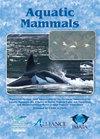哥伦比亚太平洋沿岸发现和搁浅羽鳍鱼的系统回顾:对羽鳍鱼保护的影响
IF 0.8
4区 生物学
Q4 MARINE & FRESHWATER BIOLOGY
引用次数: 0
摘要
自 1970 年以来,哥伦比亚太平洋水域就不时有关于发现针足类动物的报道。南美海狗(Arctocephalus australis)、南美海狮(Otaria byronia)、胡安费尔南德斯海狗(Arctocephalus philippii)和南象海豹(Mirounga leonina)--近来均有记录。本研究全面系统地回顾了 1970 年至 2023 年期间在哥伦比亚太平洋沿岸发现和搁浅的凤头海豹,共发现 68 次,80 只。其中,1998 年(13 只)记录到最多的是凤头鱼,其次是 2014 年(9 只)、1997 年(8 只)、1983 年(7 只)以及 1993 年、1996 年、2015 年和 2020 年(每年 3 只)。观察到的大多数凤尾鱼都是在哥伦比亚太平洋南部海岸,特别是图马科(Tumaco)发现的流浪者--孤独的年轻个体。这些物种的一些记录似乎受到该地区上升流事件和气候海洋现象变化(厄尔尼诺/南方涛动)的影响。有必要进行进一步监测,以确定该物种在哥伦比亚太平洋沿岸地区的出现和丰富程度是否与以下因素有关:(1)该物种的流浪行为;(2)与该物种种群的生物生态变化有关的栖息地使用的改变;和/或(3)与潜在的新栖息地适宜性有关的分布范围的变化。本文章由计算机程序翻译,如有差异,请以英文原文为准。
Systematic Review of Pinniped Sightings and Strandings Along the Pacific Coast of Colombia: Implications for Pinniped Conservation
Sightings of pinnipeds in Colombian waters of the Pacific Ocean have sporadically been reported since 1970. Despite the Colombian Pacific region (CPR) not being within their typical distribution range, six pinniped species—the Galápagos fur seal (Arctocephalus galapagoensis), the Galápagos sea lion (Zalophus wollebaeki), the South American fur seal (Arctocephalus australis), the South American sea lion (Otaria byronia), the Juan Fernández fur seal (Arctocephalus philippii), and the southern elephant seal (Mirounga leonina)—have been recorded in recent times. This study presents an overall systematic review of pinniped sightings and strandings from 1970 to 2023 along the Pacific coast of Colombia, with a total of 68 sightings of 80 individuals. Pinnipeds were recorded most often in 1998 (13 individuals), followed by 2014 (nine individuals); 1997 (eight individuals); 1983 (seven individuals); and 1993, 1996, 2015, and 2020 (with three individuals each year). Most pinniped observations correspond to vagrants—solitary, young individuals sighted on the southern coast of the Colombian Pacific, specifically in Tumaco. Some records of these species appear to be influenced by upwelling events and changes in climatic-oceanographic phenomena (ENSO episodes) in the region. Further monitoring is necessary to determine whether species presence and abundance in the CPR is a response to (1) vagrant behavior of the species, (2) altered habitat use associated with bioecological changes in the species populations, and/or (3) shifts in distribution ranges related to potential new habitat suitability.
求助全文
通过发布文献求助,成功后即可免费获取论文全文。
去求助
来源期刊

Aquatic Mammals
MARINE & FRESHWATER BIOLOGY-ZOOLOGY
CiteScore
1.60
自引率
16.70%
发文量
99
审稿时长
>12 weeks
期刊介绍:
Aquatic Mammals is a peer-reviewed journal sponsored by the European Association for Aquatic Mammals (EAAM), the Alliance of Marine Mammal Parks and Aquariums (AMMPA), and the International Marine Animal Trainers’ Association (IMATA). Aquatic Mammals publishes articles related to marine mammals (whales, dolphins, seals, fur seals, sea lions, walrus, dugongs, manatees, sea otters, and polar bears). Topics of publication on both captive animals and wild marine mammals include aspects of husbandry; behavior; conservation; veterinary medicine; anatomy; physiology; training; population trends; and the effects of pollution, climate change, and noise.
 求助内容:
求助内容: 应助结果提醒方式:
应助结果提醒方式:


